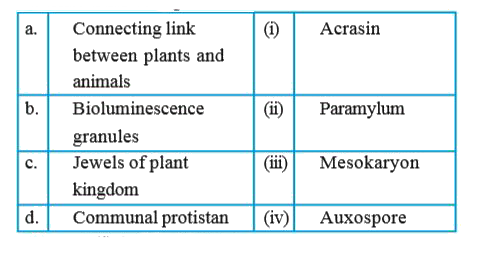Which of the following will act as cathode when connected to standard hydrogen electrode which has E∘ value given as zero ?
(i) Zn2+/Zn,E∘=−0.76V
(ii) Cu2+/Cu,E∘=+0.34V
(iii) Al3+/Al,E∘=−1.66V
(iv) Hg2+/Hg,E∘=+0.885V
(A)(i) and (ii)
(B)(ii) and (iv)
(C)(i) and (iii)
(D)(i), (ii), (iii) and (iv)
(i) and (ii)
(ii) and (iv)
(i) and (iii)
(i), (ii), (iii) and (iv)
The correct Answer is:B
To determine which of the given electrodes will act as a cathode when connected to the standard hydrogen electrode (SHE), we need to analyze the standard electrode potentials (E°) of each electrode. The standard hydrogen electrode has an E° value of 0 V.
1. Identify the Standard Electrode Potentials:
- (i) Zn²⁺/Zn, E° = -0.76 V
- (ii) Cu²⁺/Cu, E° = +0.34 V
- (iii) Al³⁺/Al, E° = -1.66 V
- (iv) Hg²⁺/Hg, E° = +0.885 V
2. Determine the Cathode:
- The cathode is the electrode where reduction occurs. For an electrode to act as a cathode when connected to the SHE, it must have a positive standard electrode potential (E° > 0 V).
- Compare the E° values:
- Zn²⁺/Zn: -0.76 V (not a cathode)
- Cu²⁺/Cu: +0.34 V (cathode)
- Al³⁺/Al: -1.66 V (not a cathode)
- Hg²⁺/Hg: +0.885 V (cathode)
3. List the Cathodes:
- The electrodes that will act as cathodes are:
- Cu²⁺/Cu (E° = +0.34 V)
- Hg²⁺/Hg (E° = +0.885 V)
4. Select the Correct Option:
- The correct option that includes both Cu²⁺/Cu and Hg²⁺/Hg is:
- (B) (ii) and (iv)
Final Answer:
The answer is (B) (ii) and (iv).
- (i) Zn²⁺/Zn, E° = -0.76 V
- (ii) Cu²⁺/Cu, E° = +0.34 V
- (iii) Al³⁺/Al, E° = -1.66 V
- (iv) Hg²⁺/Hg, E° = +0.885 V
- The cathode is the electrode where reduction occurs. For an electrode to act as a cathode when connected to the SHE, it must have a positive standard electrode potential (E° > 0 V).
- Compare the E° values:
- Zn²⁺/Zn: -0.76 V (not a cathode)
- Cu²⁺/Cu: +0.34 V (cathode)
- Al³⁺/Al: -1.66 V (not a cathode)
- Hg²⁺/Hg: +0.885 V (cathode)
- The electrodes that will act as cathodes are:
- Cu²⁺/Cu (E° = +0.34 V)
- Hg²⁺/Hg (E° = +0.885 V)
- The correct option that includes both Cu²⁺/Cu and Hg²⁺/Hg is:
- (B) (ii) and (iv)
The answer is (B) (ii) and (iv).
Topper's Solved these Questions
- BOOK - NCERT FINGERTPS ENGLISHCHAPTER - REDOX REACTIONSEXERCISE - HIGHER ORDER THINKING SKILLS9videos
REDOX REACTIONS
- BOOK - NCERT FINGERTPS ENGLISHCHAPTER - REDOX REACTIONSEXERCISE - NCERT EXEMPLAR PROBLEMS11videos
REDOX REACTIONS
- BOOK - NCERT FINGERTPS ENGLISHCHAPTER - REDOX REACTIONSEXERCISE - MCQs (OXIDATION NUMBER)70videos
REDOX REACTIONS
- BOOK - NCERT FINGERTPS ENGLISHCHAPTER - PRACTICE PAPER 3EXERCISE - Practice Paper 346videos
PRACTICE PAPER 3
- BOOK - NCERT FINGERTPS ENGLISHCHAPTER - SOME BASIC CONCEPTS OF CHEMISTRY EXERCISE - NCERT Exemplar11videos
SOME BASIC CONCEPTS OF CHEMISTRY
Similar Questions
Can a solution of 1 M ZnSO4 be stored in a vessel made of copper ? Given that
E∘Zn+2/Zn=−0.76VandE∘Cu+2/Cu=0.34VView SolutionCalculate the equilibrium constant for the reaction at 298 K
Zn(s)+Cu2+(aq)↔Zn2+(aq)+Cu(s)
Given E∘Zn2+/Zn=−0.76V and E∘Cu2+/Cu=+0.34VView Solution
1 a(iii), b(ii), c(i), d(iv)
2 a(i), b(iv), c(i), d(iii)
3 a(iv), b(i), c(iii), d(iv)
4 a(ii), b(iii), c(iv), d(i)View SolutionCalculate the equilibrium constant for the reaction at 298K.
Zn(s)+Cu2+(aq)⇔Zn2+(aq)+Cu(s)
Given, E∘Zn2+/Zn=−0.76V and E∘Cu2+/Cu=+0.34VView SolutionCalculate the equilibrium constant for the reaction at 298K.
Zn(s)+Cu2+(aq)⇔Zn2+(aq)+Cu(s)
Given, E∘Zn2+/Zn=−0.76V and E∘Cu2+/Cu=+0.34VView SolutionCalculate the maximum work that can be obtained from the daniell call given below,
Zn(s)∣∣Zn2+(aq)∣∣∣∣Cu2+(aq)∣∣Cu(s). Given that E∘Zn2+/Zn=−0.76V and E∘Cu2+/Cu=+0.34V.View SolutionE∘Cu2+/Cu=0.34V
E∘Cu+/Cu=0.522V
E∘Cu2+/Cu+=View SolutionE∘Cu2+/Cu=0.34V
E∘Cu+/Cu=0.522V
E∘Cu2+/Cu+=View SolutionE∘ of Fe2+/Fe=−0.44V,E∘ of Cu/Cu2+=−0.34V .
Then in the cellView SolutionCalculate the maximum work that can be obtained from the decimolar Daniell cell at 25∘C.
Given Ec−.(Zn2+∣Zn)=−0.76V and Ec−.(Cu2+∣Cu)=0.34VView Solution

